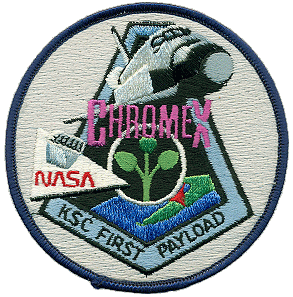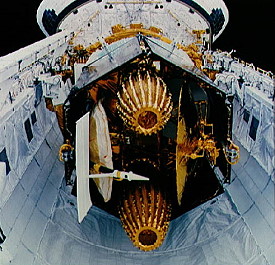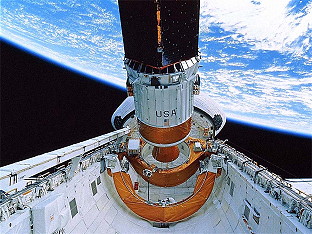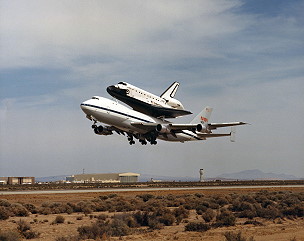Human Orbital Spaceflights
![]()
International Flight No. 121STS-29Discovery (8)28th Space Shuttle missionUSA |
 |
 |
 |
||
![]()
Launch, orbit and landing data
walkout photo |
 |
||||||||||||||||||||||||||||
alternative crew photo |
|||||||||||||||||||||||||||||
alternative crew photo |
Crew
| No. | Surname | Given names | Position | Flight No. | Duration | Orbits | |
| 1 | Coats | Michael Lloyd | CDR | 2 | 4d 23h 38m 48s | 80 | |
| 2 | Blaha | John Elmer | PLT | 1 | 4d 23h 38m 48s | 80 | |
| 3 | Springer | Robert Clyde | MS-1, EV-1 | 1 | 4d 23h 38m 48s | 80 | |
| 4 | Buchli | James Frederick | MS-2, FE | 3 | 4d 23h 38m 48s | 80 | |
| 5 | Bagian | James Philipp | MS-3, EV-2 | 1 | 4d 23h 38m 48s | 80 |
Crew seating arrangement
|
 |
|
||||||||||||||||||||||||
Hardware
| Orbiter : | OV-103 (8.) |
| SSME (1 / 2 / 3): | 2031 (1.) / 2022 (2.) / 2028 (2.) |
| SRB: | BI-031 / RSRM 3 |
| ET: | ET-38 (LWT-29) |
| OMS Pod: | Left Pod 04 (5.) / Right Pod 03 (9.) |
| FWD RCS Pod: | FRC 3 (8.) |
| RMS: | - |
| EMU: | EMU No. 1094 (PLSS No. 1013) / EMU No. 1090 (PLSS No. 1011) |
Flight
|
Launch from Cape Canaveral (KSC) and
landing on the Edwards
AFB, Runway
22. The launch was originally scheduled for February 18, 1989 but was postponed to allow for replacement of suspect liquid oxygen turbopumps on the three main engines. The amended target date of March 11, 1989 also proved unviable because of the failure of a master event controller when it was powered up during prelaunch checkout; the controller was quickly replaced. On the rescheduled launch day of March 13, 1989, the launch was delayed for nearly two hours because of ground fog and high upper winds. A waiver was approved for the orbiter's wing loads. Main goal of this mission was the deploying of the third and final communications satellite TDRS-D. Three TDRS, operating from geosynchronous orbit, are required to complete the constellation known as the Tracking and Data Relay Satellite System (TDRSS). TDRSS will increase communications, between Earth-orbiting spacecraft and a ground-based tracking station, from 15 to 85 percent per orbit and facilitate a much higher rate of data flow. The Tracking and Data Relay Satellite, TDRS-D, is the fourth TDRS communications spacecraft to be launched aboard the Space Shuttle and completes the constellation of on-orbit satellites for NASA's advanced space communications system. TDRS-1 was launched during Challenger's maiden flight (STS-6) in April 1983. The second was lost during the Challenger accident in January 1986. TDRS-3 was launched successfully on September 29, 1988, during the landmark mission of Discovery, which returned the Space Shuttle to flight (STS-26). TDRS-1 is in geosynchronous orbit over the Atlantic Ocean, just east of Brazil (41 degrees west longitude at the equator). When it was launched, it failed to reach its desired orbit because of a failure in the upper-stage booster rocket. A NASA-industry team subsequently conducted a series of delicate spacecraft maneuvers, using on board thrusters, to place TDRS-1 into the desired 22,300-mile-altitude (38,888 km) orbit. TDRS-3 is in geosynchronous orbit over the Pacific Ocean, south of Hawaii (171 degree west longitude, also over the equator). It has performed flawlessly in tests and helped support the STS-27 mission in December 1988. After its launch, TDRS-D will be designated TDRS-4. Following its arrival at geosynchronous orbit and a series of tests, it will replace the partially degraded TDRS-1 over the Atlantic. TDRS-1 then will be moved to 79 degrees west longitude, above the Equator, where it will be used as an on- orbit spare. The two operational TDRS - those located at 41 and 171 degrees west longitude - will support up to 23 user spacecraft simultaneously and provide two basic types of service: a multiple-access service that simultaneously relays data from as many as 19 low-data-rate user spacecraft; and a single-access service that provides two high-data-rate communications relays from each satellite. TDRS-D was deployed 6 hours into the mission on flight day 1. An Air Force-developed inertial upper stage (IUS) boosted the TDRS to geosynchronous orbit (22,300 miles (35,888 km) above Earth) after deployment from the Shuttle. The IUS was mated to the TDRS-D and the combination spacecraft and upper stage will be spring ejected from the payload bay of the orbiter. Following deployment, Discovery maneuvered to a safe position behind and above the TDRS-D/IUS before the first stage of the two-stage IUS motor ignited about an hour after deployment. The three-axis, stabilized upper stage maneuvered TDRS to the desired attitude where it will be configured for operation by the NASA White Sands Ground Terminal, NM. On Flight Day 1, one of three cryogenic hydrogen tanks which supplied shuttle's electricity-generating fuel cells exhibited erratic pressure fluctuations. It was deactivated while engineers studied the problem, and the crew was told to conserve electrical power. The tank was reactivated on Flight Day 3, March 15, 1989, and operated successfully thereafter. Space Station Heat Pipe Advanced Radiator Element (SHARE) flight experiment was mounted on the starboard sill of the Orbiter's payload bay with a small instrumentation package mounted in the forward payload bay. The goal of the experiment was to test a first-of-its-kind method for a potential cooling system of Space Station Freedom. The heat pipe method used no moving parts and works through the convection currents of ammonia. Three electric heaters warmed one end of the 51-foot (15.54 meters) long SHARE. The heaters turned liquid ammonia into vapor which transported the heat through the length of the pipe, where a foot-wide aluminum fin radiated it into space. The fin was cooled by the space environment, and the ammonia is in turn condensed and recirculated. Two small pipes ran through the center of the radiator down its length, branching out like the tines of a fork at the end which received heat, called the evaporator. The top pipe held the vaporized ammonia; the bottom held liquid ammonia. In the evaporator portion, a fine wire mesh wick, which worked along the same principal as the wick of an oil lamp, pulled the liquid ammonia from one pipe to the other, where it vaporized. Small grooves allowed the condensed ammonia to drop back to the bottom pipe. The radiator for SHARE weighed about 135 pounds (61.2 kg), but with its support pedestals, support beam, heaters and instrumentation package, the total experiment weighed about 650 pounds (294 kg). The system operated continuously for less than 30 minutes under powered electrical loads. The failure was blamed on the faulty design of the equipment, especially the manifold section. The Chromex experiment should determine whether the roots of a plant in microgravity will develop similarly to those on Earth. Root- free shoots of the plant's daylily and haplopappus will be used. The experiment should determine whether: The normal rate, frequency and patterning of cell division in the root tops can be sustained in space, the chromosomes and genetic makeup is maintained during and after exposure to space flight conditions, aseptically grown tissue cultured materials will grow and differentiate normally in space. The criteria for comparison included: number of roots formed, length, weight and quality based on subjective appraisal as well as quantitative morphological and histological examination. Root tip cells were analyzed for their karyotype, the configuration of chromosomes, upon return. Haplopappus dicatolydon is a unique flowering plant with four chromosomes in its diploid cells (2n=4). Daylily monocatolydon also has specific features of its karyotype 2n=22. Daylily and haplopappus gracilis were flown in the plant growth unit (PGU), located in the orbiter middeck. The PGU could hold up to six plant growth chambers (PGC). One PGC were replaced with the atmospheric exchange system that filtered cabin air before pumping through the remaining PGCs. The experimental plan was to collect and treat roots post flight, before the first cell division cycle was completed. STS-29 protein crystal growth experiments were expected to help advance a technology attracting intense interest from major pharmaceutical houses, the biotech industry and agrochemical companies. Knowing the precise structure of these complex molecules provides the key to understanding their biological function and could lead to methods of altering or controlling the function in ways that may result in new drugs. It is through sophisticated analysis of a protein in crystallized form that scientists are able to construct a model of the molecular structure. The problem is that protein crystals grown on Earth are often small and flawed. During the flight, 60 different crystal growth experiments were conducted simultaneously using 19 different proteins. The experiment apparatus, first flown aboard Discovery on STS-26, fits into one of the Shuttle orbiter's middeck lockers. The IMAX project is a collaboration between NASA and the Smithsonian Institution's National Air and Space Museum to document significant space activities using the IMAX film medium. This system, developed by the IMAX Systems Corp., Toronto, Canada, uses specially-designed 70mm film cameras and projectors to record and display very high definition large-screen color motion picture images. IMAX cameras previously have flown on Shuttle missions STS-41C, STS-41D and STS-41G to document crew operations in the payload bay and the orbiter's middeck and flight deck along with spectacular views of space and Earth. Film from those missions form the basis for the IMAX production, "The Dream is Alive". On STS-61B, an IMAX camera, mounted in the payload bay, recorded extravehicular activities in the EASE/ACCESS space construction demonstrations. The IMAX camera this time was used to gather material on the use of observations of the Earth from space for a new IMAX film to succeed "The Dream is Alive". The Air Force Maui Optical Site (AMOS) tests allowed ground- based electro-optical sensors located on Mt. Haleakala, Maui, Hawaii, to collect imagery and signature data of the orbiter during cooperative overflights. The scientific observations made of the orbiter, while performing reaction control system thruster firings, water dumps or payload bay light activation, and were used to support the calibration of the AMOS sensors and the validation of spacecraft contamination models. The AMOS tests had no payload unique flight hardware and only required that the orbiter be in predefined attitude operations and lighting conditions. Special instrumentation to record the environment experienced by Discovery during the STS-29 mission was aboard the orbiter mounted in the payload bay. The Orbiter Experiments Autonomous Supporting Instrumentation System (OASIS) was designed to collect and record a variety of environmental measurements during various in-flight phases of the orbiter. The primary device was a large tape recorder which is mounted on the aft, port side of the orbiter. The OASIS recorder could be commanded from the ground to store information at a low, medium or high data rate. The information was used to study the effects on the orbiter of temperature, pressure, vibration, sound, acceleration, stress and strain. It also will be used to assist in the design of future payloads and upper stages. The OASIS data were collected from 101 sensors mounted on three primary elements. The sensors were located along the sills on either side of the payload bay, on the airborne support equipment of the Inertial Upper Stage and on the tape recorder itself. These sensors were connected to accelerometers, strain gauges, microphones, pressure gauges and various thermal devices on the orbiter. OASIS was launched aboard Discovery on STS-26 in September 1988. Upon return to KSC, the OASIS recorder was removed from the payload bay and the tape analyzed. Use of this data improved efficiency in turnaround of the IUS airborne support equipment for Discovery's STS-29 mission. As more OASIS data are collected, it will be increasingly beneficial for future IUS flights on the Space Shuttle. Discovery also carried eight secondary payloads, including two Shuttle Student Involvement Program experiments. One student experiment, using four live rats with tiny pieces of bone removed from their bodies, was to test whether the environmental effects of space flight inhibit bone healing. The other student experiment was to fly 32 chicken eggs to determine the effects of space flight on fertilized chicken embryos. Discovery landed one orbit earlier than planned, in order to avoid possible excessive wind buildup expected at the landing site. |
Photos / Graphics
 |
 |
 |
 |
 |
 |
 |
 |
 |
 |
 |
 |
 |
 |
 |
 |
more Earth observation photos |
|
| © |  |
Last update on March 04, 2025.  |
 |